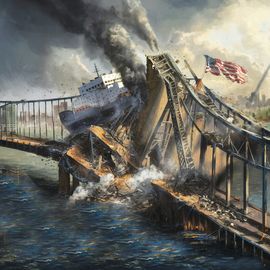The reactions on social media following the collision of the cargo ship Dali with Baltimore’s Francis Scott Key Bridge were unnecessarily derogatory. There was also a racially insensitive cartoon by a webcomic based in the US. All this and more has led to further slamming of the Indian crew on the ship.
Crew nationality is a matter of employment and not indicative of a country’s maritime safety standards. It is imperative not to jump to conclusions or assign blame solely on the nationality of the crew, but instead to conduct a thorough and impartial inquiry to determine the causes of the mishap. Who was the captain of the ship? What are the existing laws in the US in such situations? Were there any tugboats to ensure safe navigation? The swift action taken by the Indian crew to alert authorities undoubtedly played a crucial role in mitigating the extent of casualties in what could have been a far more devastating incident. Was there sabotage? Today, the Navy is securing the Indian Ocean so that world trade is protected from terrorists and pirates. Even the US President Joe Biden praised the Indian crew for a quick call for help.
Looking down at Indians in loincloth, like in the cartoon, is akin to a mindset that saw India as a land of snake charmers. It was the same cloth, mind you, from which we made masts in ships thousands of years ago. Racism of such nature needs to be checked by all governments.
India has been a maritime superpower since ancient times. Lothal, an ancient site in Gujarat, dating back to 2400 BCE, is considered the world’s oldest dry-dock. It was equipped to berth and service ships. Back then it gave us an insight into tides, winds and other nautical factors. Not just that, the navy of the Magadha kingdom is considered to be the first ever recorded instance of a navy anywhere in the world. Chandragupta Maurya’s minister, Chanakya, wrote the Arthashastra, where he shared details about the department of waterways under a navadhyaksha (superintendent of the ships). It also mentioned an admiralty division, which was responsible for navigation on the oceans, lakes and seas.
Many centuries ago people from our country had reached Zanzibar in Africa for business. In fact, it was a merchant from Gujarat named Chandan whose ship Portuguese explorer Vasco da Gama followed to reach India. He said in his diary that Indian ships were much bigger than theirs and the workmanship was so fine that that not a single drop of water could go through them.
Today, India contributes a significant chunk of seafarers to the shipping industry as the country is recognised globally as a reliable source of marine manpower. On an average, India sends around 2.4 lakh seafarers every year. Of them, 2.1 lakh seafarers work on foreign ships. India’s resolute actions in maritime security have been demonstrated through recent successful operations.
With the Navy disclosing its response to 18 incidents in recent months, employing a rotating force of 21 ships and 5,000 personnel, and conducting thorough boarding and investigation procedures on over 1,000 vessels, India has proven its commitment to safeguarding maritime interests. This proactive approach not only underscores India’s dedication to ensuring maritime security but also solidifies its position as a key player in the global maritime domain.
Lekhi is Union minister of state for external affairs and culture.


